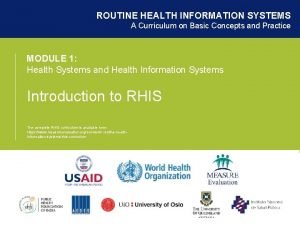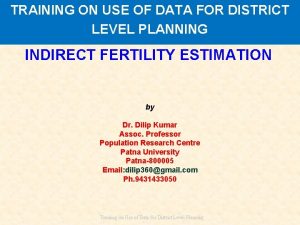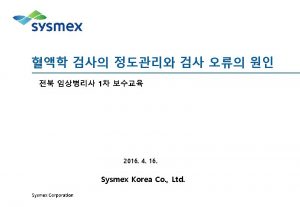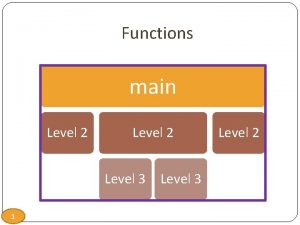TRAINING ON USE OF DATA FOR DISTRICT LEVEL





































- Slides: 37

TRAINING ON USE OF DATA FOR DISTRICT LEVEL PLANNING BASIC MEASURES OF FERTILITY AND MORTALITY by Dr. Dilip Kumar Assoc. Professor Population Research Centre Patna University Patna-800005 Email: dilip 360@gmail. com Ph. 9431433050

Learning Objectives in this Session ØThis chapter is designed to help participants understand the basic measures of fertility and mortality and to comprehend computation and interpretation ØIndirect methods of estimation of fertility and mortality shall also be familiarized in this section.

Rate

Ratio

FERTILITY MEASURES

Live birth is the complete expulsion or extraction from its mother of a product of conception, irrespective of the duration of pregnancy, which product, after such separation, breathes or shows any other evidence of life for example: § beating of the heart, § pulsation of the umbilical cord, or § definite movement of voluntary muscles whether or not the umbilical cord has been cut or the placenta is attached World Health Organization (1950, P. 17)

Still Birth is a product of conception that fails to breathe or show any other evidence of life after expulsion or extraction from the mother

Crude Birth Rate (CBR): Where, ‘B’ is the total number of live births in a year ‘P’ is the total mid-year population in the same year

Advantages of CBR: q q q It indicates the level of fertility in a data It directly points to the calculation of fertility to the growth rate of the population It requires minimum data and its computation is quick and easy Disadvantages of CBR: q q CBR is affected by many factors such as age, sex, marital composition etc. It is not very sensitive to small change in fertility

Crude Birth Rate, 2009 26 27 29 29 Source: SRS, 2011 UP BH P M J RA CH H K JH S 24 AS J 23 GU R 23 HA IN DI A 21 OR 20 KA R K J& AP DE H M W 18 L 18 17 B 17 HP PU N 16 TN KE R 15 17 19 18 23 26 28

Crude Birth Rate, 2010 -11 29 28. 5 28 27. 6 27 26. 3 26 24. 9 25 24 23 Bhagalpur Gaya Nalanda Purnia Supaul Source: AHS, 2010 -11

General Fertility Rate (GFR): It is defined as the ratio of total number of live births in a year to the total mid-year female population of child-bearing ages. Where, B is the total number of live births in a year W 15 -44 is the mid-year female population of the child bearing ages

Advantages of GFR: § It is a more acceptable measure of fertility level because it removes from the denominator most of the population who are not directly exposed to child bearing § It is easy to compute Disadvantages of GFR: § Unmarried women are also included in the denominator § It does not control variations in age composition within the reproductive age group

Age Specific Fertility Rate (ASFR): It is defined as the number of births per year per 1000 women of a specified age. Where, 5 fx is ASFR of women aged ‘x’ to ‘x+5’ 5 Bx is number of births to women aged ‘x’ to ‘x+5’ 5 WX is number of women aged ‘x’ to ‘x+5’

Advantages of ASFR: § ASFR is not affected by any variations in the age structure § A schedule of ASFRs reveal more information about the childbearing situation of a population at a given moment than any other measures of fertility Disadvantage of ASFR: § When comparison between two population group has to be made § Procedure is cumbersome

Example of Age-specific Fertility rates, Bihar, 2001 Age of Woman ‘x’ to ‘x+n’ Mid-year number of Women 5 Wx Number of births by age of mother, 5 Bx Age-specific fertility rate 5 Fx =5 Bx /5 Wx Age-specific fertility rate 5 Fx =(5 Bx /5 Wx ) x 1000 (per woman) (per 1000 women) 15 -19 3161545 101640 . 032 32 20 -24 3143130 451282 . 144 25 -29 3013602 448469 . 149 30 -34 2835916 328839 . 116 35 -39 2501846 200254 . 080 80 40 -44 1939433 105492 . 054 54 45 -49 1683296 69160 . 041 41

Graphic presentation of Age-Specific Fertility Rates, Bihar 2001 Age-Specific Fertility Rates (per 1000 women)

Total Fertility Rate (TFR): It is defined as the average number of children a cohort of women would bear if they survived through the entire reproductive ages and experienced a fixed schedule of fertility rate. Where, ASFR is the age specific fertility rate

Advantages of TFR: § It is an effective summary rate for describing the frequency of child bearing in a year § It is a standardized measure of fertility § It is useful for comparing the fertility levels of two populations § It provides the average completed family size § Disadvantage of TFR: § It does not provide any information about the distribution of fertility among the age groups which can influence the value of CBR and thus the growth rate of population

Total Fertility Rate, 2008 3. 0 3. 3 Source: SRS, 2009 BH K M P RA J UP JH IN DI A CH H 2. 6 AS R HA J GU OR JK M H 2. 0 N W B DE L KA R PU HP 1. 8 AP TN KE R 1. 7 1. 9 2. 2 2. 4 2. 5 3. 2 3. 9

Measures of Reproduction

Gross Reproduction Rate (GRR): It is defined as the number of daughters that a cohort of women would bear if they survived through the entire reproductive ages and experienced a fixed schedule of fertility. Where, f 5 B x is the number of female live births to women of the age group ‘x’ to ‘x+5’ 5 Wx is the mid-year female population of the age group ‘x’ to ‘x+5’

Points to be noted

Sex Ratio at Birth (SRB)

Sex Ratio at Birth(Female per 1000 male) India & Major States 2011 1084 Source: Census, 2011 hi De l K J& ab nj Pu UP r ha j Bi Gu AP ah M Ra j P M a di In Jh k B W m sa As Ka r HP a ris Or tt Ch a TN Ke rla 995 991 978 974 968 954 947 940 930 926 925 920 918 916 908 893 883 866

Net Reproduction Rate (NRR): It is defined as the total number of daughters that a cohort of women would bear if they survived through the entire reproductive ages and experienced a fixed schedule of fertility and fixed age specific mortality rates. Where, 5 Bx f 5 Wx 5 Lx / = Female births to the women in the age group ‘x’ to ‘x+5’ = Women in the age group ‘x’ to ‘x+5’ 5 * l 0 = Survivorship ratio

Concept: Replacement level fertility § Replacement-level fertility: § is defined as “the number of children that women, on average, must produce in order for a population to ultimately reach a stationary state (“zero population growth” position) – neither growing nor declining”. § An NRR of 1. 0 (or unity) is equal to replacement level. § In the developed countries today, § TFR =2. 1 births per woman, § GFR =60 births per 1000 women aged 15 -49 per year or § CBR =16 births per 1000 population per year § are considered to represent approximate replacement level.

MORTALITY MEASURES

Death: It is the permanent disappearance of all evidence of life at any time after a birth has taken place Maternal Death: is the death of a woman while pregnant or within 42 days of termination of pregnancy, irrespective of the duration and site of the pregnancy, from any cause related to or aggravated by the pregnancy or its management but not from accidental or incidental causes. To facilitate the identification of maternal deaths in circumstances in which cause of death attribution is inadequate, a new category has been introduced: Pregnancy-related death is defined as the death of a woman while pregnant or within 42 days of termination of pregnancy, irrespective of the cause of death. (WHO)

Crude Death Rate (CDR) It is defined as the number of deaths in a year in a geographical area per 1000 of the mid year population. Where, ‘D’ is the total number of deaths in an area during a calendar year ‘P’ is the mid-year population of the area in the same calendar year

Crude Death Rate, 2009 8. 1 8. 2 7. 0 6. 8 6. 9 6. 7 6. 6 6. 2 7. 3 8. 8 8. 4 8. 5 7. 6 5. 7 Source: SRS, 2011 R O P M SS A P U H C H P A TN IA D R IN A K P H BH K JH N PU J U G ER K H M J A R R A H B W K & J D EL 4. 4

Crude Death Rate, 2010 -11 9. 0 8. 0 7. 4 7. 2 7. 0 6. 5 5. 0 4. 0 3. 0 2. 0 1. 0 0. 0 Bhagalpur Gaya Nalanda Purnia Supaul Source: AHS, 2010 -11

Age Specific Death Rate (ASDR) It is defined as the number of deaths in an geographical area among a population between ages ‘x’ to ‘x+5’ (x+n) during a calendar year by 1000 of the mid year population in the given area between ages ‘x’ to ‘x+5’ (x+n). Where, 5 DX is the death in an geographical area among a population between ages ‘x’ to ‘x+5’ during a calendar year 5 Px is the mid year population in the given area between ages ‘x’ to ‘x+5’

Infant Mortality Rate, 2009 59 48 45 44 49 50 51 51 63 61 67 65 54 52 38 31 28 33 33 Source: SRS Bulletin, 2011 P M R O P U SS A J A R H H C BH IN P D IA H A R K A R A J U G K & K J JH N PU B W EL D H TN M K ER 12

Infant Mortality Rate, 2010 -11 70 62 60 54 55 Bhagalpur Gaya 64 52 50 40 30 20 10 0 Nalanda Purnia Supaul Source: AHS, 2010 -11

Child and Under-5 Mortality Rates

Thank you
 District level routine information system
District level routine information system Fspos
Fspos Typiska drag för en novell
Typiska drag för en novell Tack för att ni lyssnade bild
Tack för att ni lyssnade bild Ekologiskt fotavtryck
Ekologiskt fotavtryck Varför kallas perioden 1918-1939 för mellankrigstiden?
Varför kallas perioden 1918-1939 för mellankrigstiden? En lathund för arbete med kontinuitetshantering
En lathund för arbete med kontinuitetshantering Särskild löneskatt för pensionskostnader
Särskild löneskatt för pensionskostnader Tidböcker
Tidböcker Anatomi organ reproduksi
Anatomi organ reproduksi Vad är densitet
Vad är densitet Datorkunskap för nybörjare
Datorkunskap för nybörjare Stig kerman
Stig kerman Debatt mall
Debatt mall Magnetsjukhus
Magnetsjukhus Nyckelkompetenser för livslångt lärande
Nyckelkompetenser för livslångt lärande Påbyggnader för flakfordon
Påbyggnader för flakfordon Arkimedes princip formel
Arkimedes princip formel Offentlig förvaltning
Offentlig förvaltning Lyckans minut erik lindorm analys
Lyckans minut erik lindorm analys Presentera för publik crossboss
Presentera för publik crossboss Vad är ett minoritetsspråk
Vad är ett minoritetsspråk Plats för toran ark
Plats för toran ark Treserva lathund
Treserva lathund Epiteltyper
Epiteltyper Claes martinsson
Claes martinsson Centrum för kunskap och säkerhet
Centrum för kunskap och säkerhet Lågenergihus nyproduktion
Lågenergihus nyproduktion Bra mat för unga idrottare
Bra mat för unga idrottare Verktyg för automatisering av utbetalningar
Verktyg för automatisering av utbetalningar Rutin för avvikelsehantering
Rutin för avvikelsehantering Smärtskolan kunskap för livet
Smärtskolan kunskap för livet Ministerstyre för och nackdelar
Ministerstyre för och nackdelar Tack för att ni har lyssnat
Tack för att ni har lyssnat Mall för referat
Mall för referat Redogör för vad psykologi är
Redogör för vad psykologi är Matematisk modellering eksempel
Matematisk modellering eksempel Tack för att ni har lyssnat
Tack för att ni har lyssnat





























































